19 Black and Orange Caterpillars (With Pictures) – Identification Guide

Black and orange caterpillars represent the larval stage of various moths and butterflies. These chubby, worm-like crawling insects can feature black and orange stripes, fuzzy orange bodies with black bands, or tufts of spiny hairs protruding from their black and orange forms. Certain orange and black fuzzy caterpillars may even appear intimidating, with noticeable black spikes adorning their backs and heads.
Just because a black caterpillar has orange stripes doesn’t mean that the moth or butterfly will have similar colors. For example, the hairy black and orange woolly bear caterpillar transforms into the spectacular Isabella Tiger Moth (Pyrrharctia isabella). This moth displays varying shades of cream, orange, and brown, often with specks of black.
Additionally, the orange-spotted Oleander Moth Caterpillar (Syntomeida epilais) with its long black spikes metamorphoses into a beautiful metallic blue moth.
Furthermore, there is a black caterpillar with orange tufts that transforms into the brown Rusty Tussock Moth (Orgyia antiqua).
This article is a guide to identifying some of the most stunning black and orange caterpillars. Descriptions of the larval insects and pictures of the orange and black caterpillars will help determine what species of butterfly they turn into.
Are Black and Orange Caterpillars Venomous?
Orange and black caterpillars are typically not venomous and are safe to touch. Even though some furry black and orange caterpillars look dangerous due to their horns, bristles, prickly spines, or tufts of hairs, they don’t usually sting. However, some people may get an allergic reaction after handling a bristly caterpillar.
For example, the menacing-looking black caterpillar with black spike and orangey-red dots, the Mourning Cloak Caterpillar (Nymphalis antiopa), looks like it’s a type of stinging caterpillar. However, the caterpillar’s appearance is deceiving because it’s completely harmless.
Some black and orange caterpillars are poisonous to certain animals. For example, the striped black and orange Cinnabar moth caterpillar (Tyria jacobaeae) feeds on ragwort and stores the poisons in its body. In large amounts, the caterpillars could poison small rodents or birds.
Black and Orange Caterpillar Identification
Black and orange caterpillars are identifiable by their distinctive worm-like body shape, head shape, six legs, stumpy-looking prolegs, and the appearance of spines or bristles. In many cases, certain types of caterpillars only feed on a specific plant, which can help identify the black and orange worm-like insects.
When comparing pictures of caterpillars for identification, it’s essential to remember that caterpillars go through several stages called instars. Therefore, a juvenile caterpillar that’s just hatched may look completely different from a mature caterpillar that’s about to enter the pupal stage.
All caterpillars are a type of insect in the order Lepidoptera. There are over 180,000 caterpillar species in the world that turn into types of moths or beautiful butterflies. Depending on the species, black and orange caterpillars can measure less than 1” (2.5 cm) and up to 6” (15 cm) long.
Types of Black and Orange Caterpillars (With Pictures)
A caterpillar is the larval stage of a moth or butterfly. It’s part of their four-stage life cycle: egg, larva, pupa, and adult. The caterpillar is the important second stage in this transformation process.
Let’s look in more detail at some spectacular examples of black and orange caterpillars. In this list, you will discover caterpillars that are described as woolly, fuzzy, smooth with spikes, bristled, colorful, and striped.
Woolly Bear Caterpillar (Pyrrharctia isabella)
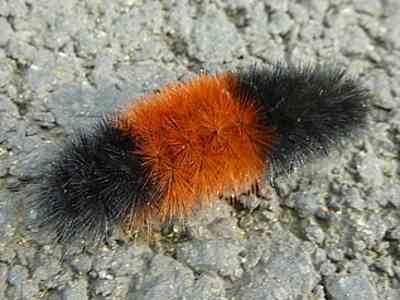
Isabella tiger moth caterpillar is a black and orange fuzzy caterpillar
The woolly bear is a black and orange fuzzy caterpillar, notable for the wide rusty-orange band around its middle and fuzzy black ends. It also features distinctive orange forelegs, a small head, and an overall black and orange appearance.
This fuzzy woolly worm measures 2.4 inches (6 cm) in length and feeds on various plant leaves. Upon transformation, it becomes the spectacular Isabella Tiger Moth (Pyrrharctia isabella), displaying varying shades of cream, orange, and brown, often with specks of black. Other names for the woolly bear include banded woolly bear, woolly worm, or black-ended bear caterpillar.
According to folklore, the woolly bear caterpillar, with its distinct bands of black and rusty orange, is believed to predict the severity of the upcoming winter. The wider the orange band, as per the legend, the milder the winter will be. Conversely, a narrower band suggests a harsher winter ahead. While this belief lacks scientific backing, the woolly bear caterpillar’s unique appearance has long captured the imagination of those looking for signs of what the future holds in terms of seasonal weather patterns.
Black and Orange Caterpillar Identification
Identify an orange and black woolly bear caterpillar by the tufts of short black or reddish-orange hairs covering the furry caterpillar’s body.
- Adult Stage: The adult form of this caterpillar is the Isabella Tiger Moth
- Host Plants: Woolly Bear Caterpillars are known to feed on a variety of plants such as dandelions, violets, clover, plantain, and nettle
- Habitat and Distribution: They can be found in open fields, gardens, and meadows in the United States, southern Canada, and Mexico
- Stinging: Handling one of these fuzzy woolly worms with their spiky tufts of hair may cause skin irritation, contact dermatitis, or a rash.
Oleander Caterpillar (Syntomeida epilais)
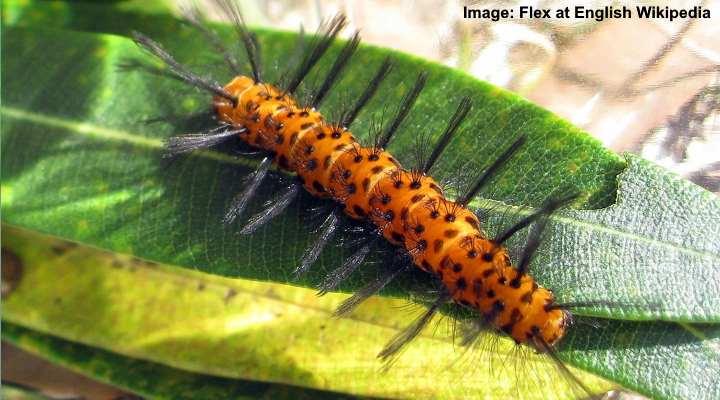
The oleander caterpillar has orange body with black bumps and tufts of hair
The oleander moth caterpillar is a bright orange caterpillar with tufts of long black spines growing from black bumps, making the caterpillar look like a bottle brush. This orange and black caterpillar species has a voracious appetite and quickly decimates foliage on oleander or desert rose plants.
Oleander caterpillars grow to be about 1.5” (4 cm) long, going through several stages of development before reaching maturity. During the later stages of their life cycle, they undergo a remarkable metamorphosis, transforming into the strikingly beautiful and eye-catching adult form known as the polka-dot wasp moth.
The adult moth is characterized by its mesmerizing blue hue, along with iridescent coloring and distinctive polka-dot patterns on its wings.
It is important to note that these adult moths do not feed on oleander or desert rose plants. Instead, they primarily consume nectar from various flowers, playing a crucial role in pollination and contributing to the ecological balance of their habitats.
The oleander moth caterpillar has some level of toxicity as it contains toxins derived from the plant it feeds on, the oleander. The caterpillar is particularly known for sequestering toxic substances from the plant, making it both poisonous and unpalatable to potential predators.
Black and Orange Caterpillar Identification
The oleander moth caterpillar is easily identified by its bright orange body with clusters of long, black spines resembling a bottle brush. It can be found feeding on oleander or desert rose plants. Measuring up to 1.5 inches (4 centimeters) in length, these voracious feeders quickly cause foliage damage, often clustering noticeably on the host plants.
- Adult Stage: Oleander Moth
- Host Plants: The oleander moth caterpillar primarily feeds on oleander, desert rose, and devil’s potato plants.
- Habitat and Distribution: The oleander caterpillar is native to the Caribbean region, with its habitat stretching from northern South America through Central America into Mexico. It can also be found on numerous Caribbean islands, as well as in Florida and the coastal regions of southeastern states
- Stinging: While the Oleander Caterpillar does not sting, its hairs may cause skin irritation upon contact, leading to discomfort and itching.
Redhumped Moth Caterpillar (Schizura concinna)
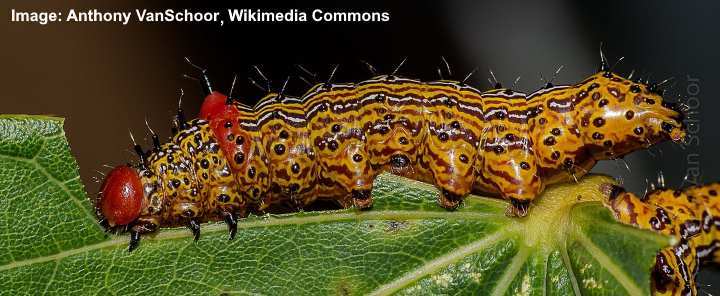
The attractive-looking redhumped caterpillar has orangey-yellow, black and white striped body with red head
The redhumped caterpillar is a long caterpillar with longitudinal black and orange or yellow stripes, short black fleshy tubercles, and an orangey-red rounded head and hump on its back. As the striped caterpillars mature, they develop yellowish-orange bodies with black and white stripes. Redhumped caterpillars grow up to 1.5” (3.8 cm) long.
A characteristic trait of redhumped caterpillars is that they feed in clusters. Therefore, a large group of these leaf-munching caterpillars can quickly defoliate fruit trees, walnut trees, cottonwood trees, and willow trees.
Black and Orange Caterpillar Identification
The redhumped moth caterpillar has an identifiable red head, reddish hump, black spikes, and a yellowish-orange body with stripes.
- Adult Stage: Redhumped Moth
- Host Plants: Fruit trees, walnut trees, cottonwood trees, and willow trees
- Habitat and Distribution: Deciduous forests and woodlands across North America
- Stinging: This caterpillar does not sting, although some individuals might be sensitive to its tiny spines, causing mild irritation.
Cinnabar Moth Caterpillar (Tyria jacobaeae)
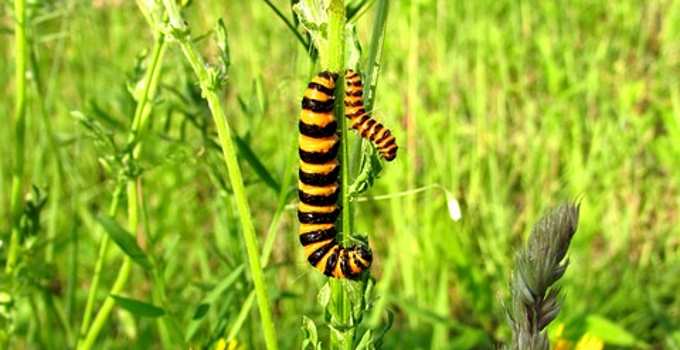
The cinnabar caterpillar has pale orange and black stripes with fine hairs on its body
The cinnabar caterpillar is a black and yellow/orange striped caterpillar with long feathery spines on its body. Up close, you’ll notice three pairs of black legs at the front and four pairs of black and orange prolegs in the middle section of its body. Cinnabar caterpillars can grow up to 1.2” (3 cm) in length.
Because it is mainly found feeding on ragwort, the banded orange and black cinnabar caterpillar is poisonous to any predators who eat it. In addition, due to their voracious appetite, the destructive caterpillars can strip plants of leaves.
The cinnabar caterpillar can also be a type of black and yellow caterpillar.
Black and Orange Caterpillar Identification
The identifying characteristic of the cinnabar moth caterpillar is the orange and black bands around the caterpillar’s body.
- Adult Stage: Cinnabar Moth
- Host Plants: Commonly found on ragwort and groundsel plants
- Habitat and Distribution: Found in grasslands, meadows, and open spaces across Europe and parts of Asia.
- Stinging: The Cinnabar Moth Caterpillar does not sting or cause skin irritation.
Yellow-Tail Moth Caterpillar (Sphrageidus similis or Euproctis similis)
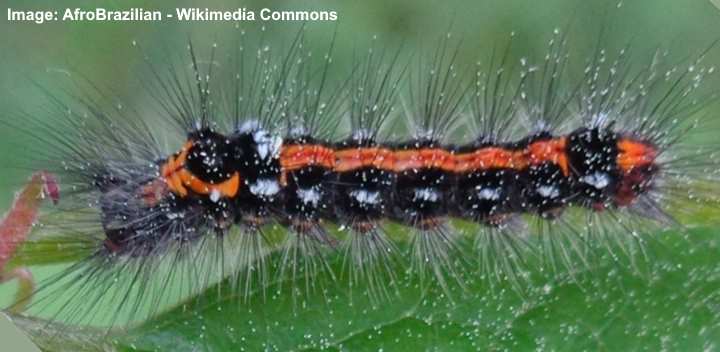
The hairy yellow-tail moth caterpillar is identified by its black body with orange lines on its back and white spots on the sides
The fuzzy yellow-tail moth caterpillar has a black spiny body with two orange bands running down its back. Other recognizable features of this hairy caterpillar are white patches on the segments, orangey-red bumps at its head, and a menacing look. This stunning black and orange caterpillar turns into a spectacular white moth with a yellow tail.
The yellow-tail moth caterpillar measures up to 1.2” (3 cm) long. You will find this spiny black and orange caterpillar feeding on birch tree leaves, fruit tree foliage, and the leaves of hawthorn, oak, and rowan.
Black and Orange Caterpillar Identification
The identifying features of the yellow-tail moth caterpillar are its black, orange, and white bands running lengthwise and tufts of white and black long spines.
- Adult Stage: Yellow-Tail Moth
- Host Plants: Feeds on a variety of trees including oak, willow, and maple
- Habitat and Distribution: Found in various regions of North America, particularly in forested areas and urban settings.
- Stinging: The Yellow-Tail Moth Caterpillar is covered in fine hairs that may cause skin irritation; however, it does not sting.
Garden Tiger Moth Caterpillar (Arctia caja)
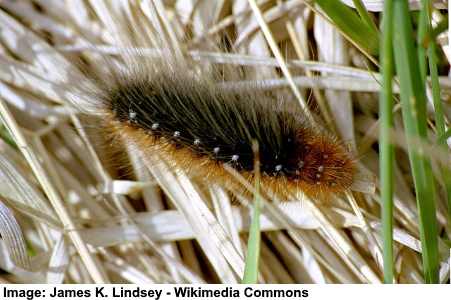
The fuzzy garden tiger moth caterpillar has black, orange and gray hair-like spines
The woolly garden tiger moth caterpillar is a hairy orangey-black caterpillar covered in long black, orange, and white spines. Also called woolly bear caterpillars, the long spiny hairs can cause skin irritation if you handle them. The large hairy caterpillars grow up to 2.4” (6 cm) long.
The black and orange garden or great tiger moth caterpillar transforms into the stunning brown and white moth with leopard-like patterns on its wings.
Black and Orange Caterpillar Identification
To identify the garden tiger moth caterpillar, look for a black, hairy caterpillar with orange coloring along its sides.
- Adult Stage: The adult form of this caterpillar is the Garden Tiger Moth
- Host Plants: These caterpillars are known to feed on a wide range of plants, including dandelions, nettles, and other herbaceous vegetation
- Habitat and Distribution: Garden Tiger Moth Caterpillars are found in various habitats such as meadows, gardens, and grassy areas throughout Europe, Asia, and North America
- Stinging: They are not known to sting but their fuzzy spines can cause skin irritation
Gulf Fritillary / Passion Butterfly (Agraulis vanillae)

The spiky gulf fritillary caterpillar has orange body with black or gray stripes along its sides
The gulf fritillary caterpillar is a dark orange caterpillar with grayish-black stripes and covered in black spikes that have tiny hairs on them. The orange and black gulf fritillary caterpillar grows up to 0.5” (1.2 cm) long. As the caterpillar matures, it becomes a dark, rusty orange color before it pupates.
The small orange and black gulf fritillary caterpillars mainly feed on foliage from plants belonging to the Passifloraceae family. Therefore, its other common name is passion butterfly caterpillar.
Black and Orange Caterpillar Identification
The gulf fritillary is easy to identify due to its smooth orange and black/gray body covered with shiny black spines.
- Adult Stage: Gulf Fritillary Butterfly
- Host Plants: Passionflowers (Passiflora species) are the primary host plants for this caterpillar.
- Habitat and Distribution: Found in the southern United States, Central and South America, and as far south as Argentina.
- Stinging: The Gulf Fritillary Caterpillar does not sting.
Spiny Oakworm Caterpillar (Anisota stigma)
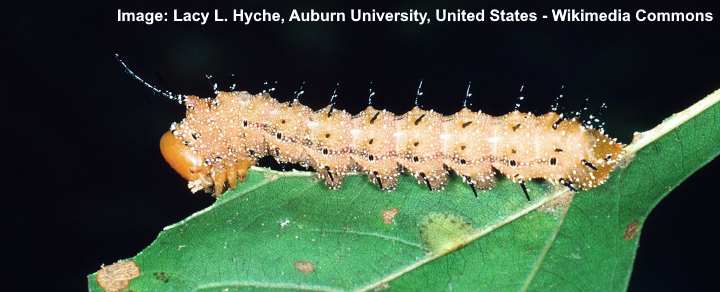
The spiny oakworm caterpillar has pale orange body with black spikes and black horn at its head
The spiny oakworm is one of the most unusual types of orange caterpillars with black spines. The pale orange caterpillar has numerous black spines on its body. You will also see that the orange caterpillar is covered in white dots. There is also a large black horn at its bulbous orange head.
The orange and black spiny oakworm caterpillar is solitary and mainly feeds on oak trees. It is active during late July when it munches its way through oak leaves. This spiny orange caterpillar with black spikes turns into a spectacular furry orange and pink moth.
Black and Orange Caterpillar Identification
Easy to identify, the orange spiny oakworm has recognizable black spines and is covered in tiny white dots. Also, look for the identifiable curved black horn at its head.
- Adult Stage: Spiny Oakworm Moth
- Host Plants: Feeds primarily on oak trees.
- Habitat and Distribution: Found in forests and wooded areas across the eastern United States.
- Stinging: The Spiny Oakworm Caterpillar has spiny hairs, and some individuals may experience mild skin irritation upon contact, but it is not generally considered to be a significant stinging threat.
Rusty Tussock Caterpillar (Orgyia antiqua)
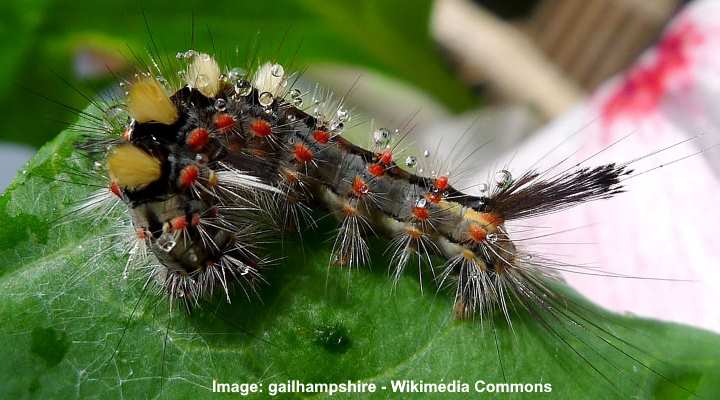
The beautiful rusty tussock caterpillar is easily identified by its unique look
The spectacular rusty tussock moth caterpillar is easily identifiable by its horn-like tufts of orange and yellow hairs on a black body. However, the easiest identifying feature to spot is the four toothbrush-like yellowish tufts on the caterpillar’s back. Also, look for orangey-red tubercles along its back and side to identify this hairy caterpillar.
Also called vapourer caterpillars, the orange and black hairy caterpillar grows between 1.2” and 1.6” (3 – 4 cm) long.
Black and Orange Caterpillar Identification
The rusty tussock caterpillar has easily identifiable horns, humps, and a tail and is covered in black, orange, yellow, and white irritating bristle-like hairs with four clumps of hairs on its black body.
- Adult Stage: Rusty Tussock Moth
- Host Plants: Feeds on a variety of trees and shrubs including oak, willow, and apple trees.
- Habitat and Distribution: Found in various regions of Europe, Asia, and North America, particularly in forested areas and gardens.
- Stinging: The Rusty Tussock Caterpillar is covered in bristles that can cause skin irritation upon contact, leading to mild stinging and discomfort in some individuals.
Fox Moth Caterpillar (Macrothylacia rubi)

The furry black fox moth caterpillar has orange marking along its back
The fox moth caterpillar is a black hairy caterpillar with bright orange segments and covered in black hairs. The furry black and orange caterpillar measures up to 3” (8 cm) long. The black fox moth caterpillar turns into an attractive tan-colored furry moth that has a large body.
Fox moth caterpillars can be found feeding on small shrubs, flowering perennials, and trees such as birch trees, willows, and plants in the bean family.
Black and Orange Caterpillar Identification
The fox moth caterpillar is identified by its hairy black body and bright yellow or orange markings running along its back.
- Adult Stage: Fox Moth
- Host Plants: Feeds on various plants including heather, bilberry, and clover.
- Habitat and Distribution: Found in grasslands, heathlands, and moorlands across Europe and parts of Asia.
- Stinging: The Fox Moth Caterpillar does not have strong stinging capabilities, although its bristles may cause mild skin irritation in some people..
Drinker Moth Caterpillar (Euthrix potatoria)
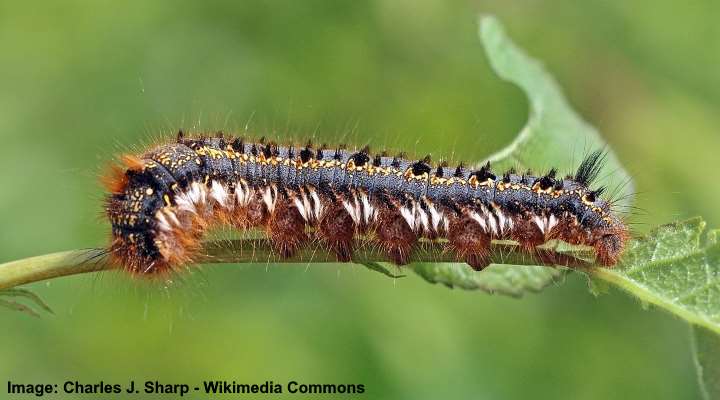
The drinker moth caterpillar is a furry orange, black and white caterpillar
The drinker moth caterpillar is a hairy orange caterpillar with a black back and lines of orange dots. You will also notice tufts of orange, white, and black hairs on its back and head. Also, look for the four pairs of hairy orange prolegs on the caterpillar’s middle segments.
Drinker moth caterpillars grow up to 2.4” (6 cm) long and turn into furry orange moths.
Black and Orange Caterpillar Identification
You can identify the drinker moth caterpillar by its orangey tufts of hair, black and orange bands running lengthwise on its back, and a rounded head.
- Adult Stage: Drinker Moth
- Host Plants: Feeds on a variety of grasses and low-growing plants.
- Habitat and Distribution: Found in grasslands, meadows, and open spaces across Europe and parts of Asia.
- Stinging: The Drinker Moth Caterpillar does not sting.
Cape Lappet Moth Caterpillar (Eutricha capensis)
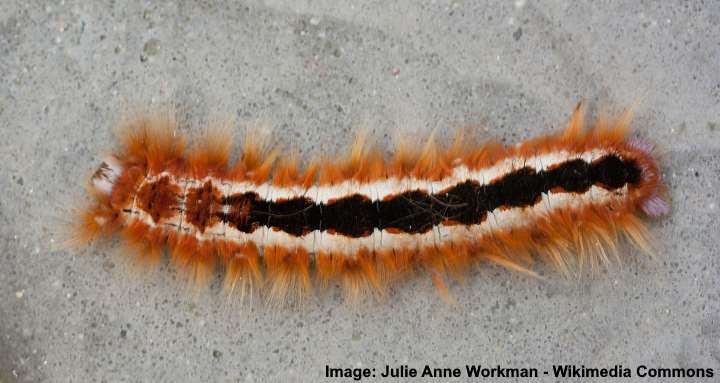
The cape lappet moth caterpillar is easily identified by its orange hairs on the sides and black and white back
The cape lappet caterpillar has clusters of brightly colored orangey hairs along its sides and a black band running lengthwise down its white back. In addition, you will notice three coppery-orange tufts of hairs at its head. One of the hairiest orange and black caterpillars, this cape lappet moth caterpillar measures up to 2.4” (6 cm) long.
Black and Orange Caterpillar Identification
To identify the cape lappet caterpillar, look for the bright orange tufts of hair on both sides and black and white back.
- Adult Stage: Cape Lappet Moth
- Host Plants: Feeds on various trees and shrubs in the Cape region of South Africa.
- Habitat and Distribution: Found in the Cape region of South Africa.
- Stinging: The Cape Lappet Moth Caterpillar is covered with urticating hairs
Imperial Moth Caterpillar (Eacles imperialis)
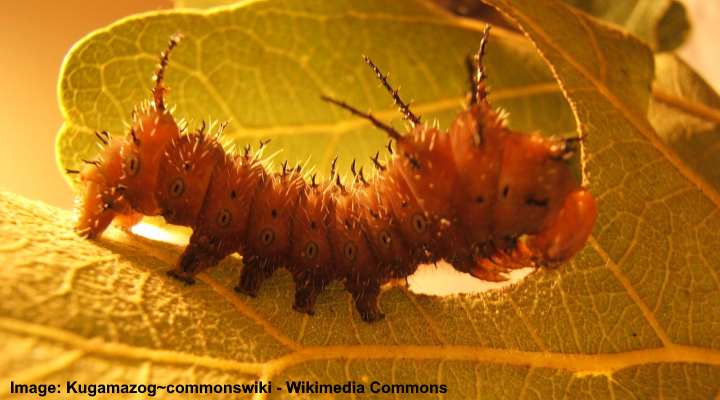
The imperial moth caterpillar can greatly vary in color. This is a close up picture of the caterpillar’s third instar
One of the scariest-looking orange and black caterpillars is the imperial moth caterpillar. This orangey black caterpillar changes its appearance during each instar. First, the spiky caterpillars can be yellow with black stripes. Then it turns a rusty red color or orange with spiny hairs. During the last stage, the intimidating caterpillars can be brown, maroon or green.
Imperial moth caterpillars grow between 0.4” to 4” (1 – 10 cm long).
Black and Orange Caterpillar Identification
The imperial moth caterpillar is challenging to identify because it changes so often. However, the spiky caterpillar has four large spiny black horns at its head and several shorter spikes and hairs on its body.
- Adult Stage: Imperial Moth
- Host Plants: Feeds on a variety of trees including oak, maple, and pine.
- Habitat and Distribution: Found in forests and woodlands across North America, particularly in the eastern regions.
- Stinging: The Imperial Moth Caterpillar is not known to have strong stinging capabilities, although its spiny hairs may cause mild skin irritation in some individuals.
Mourning Cloak Caterpillar / Spiny Elm Caterpillar (Nymphalis antiopa)
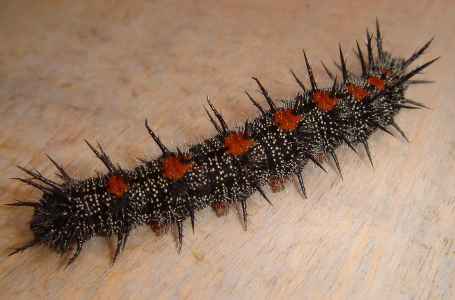
The spiky black mourning cloak caterpillar has orange-red markings and tiny white dots on its body
The mourning cloak butterfly caterpillar is a spiky black caterpillar that has eight orangey-red dots on its back. Up close, white dots and tufts of short hairs and black spine help identify the spiny mourning cloak caterpillar. The caterpillar’s black body measures 2” (5 cm) long.
Black and Orange Caterpillar Identification
To identify the mourning cloak caterpillar, look for a black body with orange dots on each segment. The body is covered in white hairs and soft black spikes.
- Adult Stage: Mourning Cloak Butterfly
- Host Plants: Mourning Cloak Caterpillars primarily feed on leaves of deciduous trees such as willow, poplar and elm. But may also eat leaves from other trees and shrubs such as hackberry, and birch
- Habitat and Distribution: These caterpillars can be found in forests, woodlands, and other wooded areas across North America, including parts of the United States and Canada
- Stinging: The caterpillars of the Mourning Cloak Butterfly are covered with urticating hairs that can cause skin irritation. While the caterpillar appears spiky and intimidating, its spines are not venomous and are primarily a defense mechanism against predators.
Spurge Hawk-Moth Caterpillar (Hyles euphorbiae)
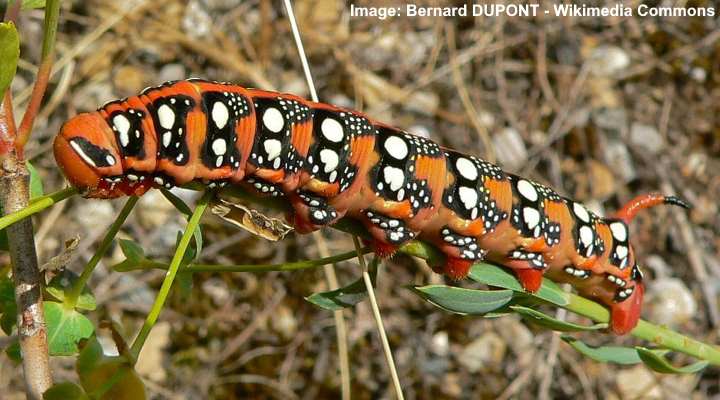
The large spurge hawk-moth caterpillar has black and orange body with white spots and a horn at its rear
The spurge hawk-moth caterpillar is a smooth black and orange caterpillar with an orange head, orange legs, and orange prolegs. At its tail end is a black-tipped orange horn. Other identifiable features of the black caterpillar are bands of white dots and a yellow abdomen.
The enormous black, orange and white caterpillars can measure up to 4” (10 cm) long and are found feeding on sea spurge plants.
Black and Orange Caterpillar Identification
The spurge hawk-moth caterpillar is easy to identify thanks to its smooth black and orange body, numerous white dots, and orange legs, head, tail, and horn.
- Adult Stage: Spurge Hawk-Moth
- Host Plants: Feeds on various species of spurge plants (Euphorbia species).
- Habitat and Distribution: Found in various regions across Europe, Asia, and parts of Africa.
- Stinging: The Spurge Hawk-Moth Caterpillar is not a stinging caterpillar.
Milkweed Tiger Moth Caterpillar (Euchaetes egle)

The unusual looking milkweed tiger moth caterpillar has tufts of orange, black and white-gray hairs
The milkweed tiger moth is a type of black hairy caterpillar with bright orange tufts of hair in its final instar. The fuzzy black, orange, and grayish larvae can grow to 1.4” (3.5 cm) long. You will often find this hairy caterpillar feeding on dogbane and milkweed plants where it skeletonizes leaves.
Black and Orange Caterpillar Identification
To identify the milkweed tiger moth, look for black hair tufts covering the larvae and orange clumps of hairs growing on its back, and a few tufts of grayish or whitish hairs.
- Adult Stage: Milkweed Tiger Moth
- Host Plants: Feeds primarily on milkweed plants.
- Habitat and Distribution: Found in open fields, meadows, and grasslands across North and Central America.
- Stinging: The Milkweed Tiger Moth Caterpillar is not known to have stinging capabilities.
Giant Sphinx caterpillar (Pseudosphinx tetrio)
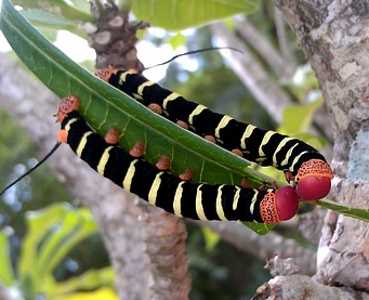
The yellow and black striped giant sphinx caterpillar has red/orange head, tail and prolegs
The enormous black and yellow striped giant sphinx caterpillar has a bright orange head, eight orange prolegs, and an orange tail with a long black spike. Close-up pictures of this striped caterpillar reveal it’s coated in urticating barbed hairs that can cause severe irritation. The giant sphinx caterpillar measures 6” (15 cm) long.
Black and Orange Caterpillar Identification
One of the most easily identifiable caterpillars due to its jet black body, orange legs, head, and tail, and yellow bands separating the segments.
- Adult Stage: Giant Sphinx Moth
- Host Plants: Feeds on various plants, including members of the Annonaceae family.
- Habitat and Distribution: Found in tropical and subtropical regions of the Americas, particularly in Central and South America.
- Stinging: The Giant Sphinx caterpillar, like other members of its species, is not stinging.
Old World Swallowtail Caterpillar (Papilio machaon)
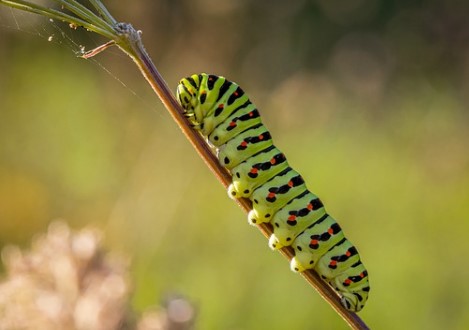
The colorful old world swallowtail caterpillar has green body, black stripes and orange dots
The old world swallowtail caterpillar is a green caterpillar with orange and black bands wrapping around its segments. This fat caterpillar has a plump body that measures 1.8” (4.5 cm) long.
This colorful caterpillar turns into a beautiful swallowtail butterfly with creamy white and black wings with blue and red markings.
Black and Orange Caterpillar Identification
The old world swallowtail caterpillar has a bright green body with bands of black and orange markings. You can identify the plump caterpillar by its raised front section when it feels threatened.
- Adult Stage: Old World Swallowtail Butterfly
- Host Plants: Feeds on a variety of plants in the carrot family, including parsley, dill, and fennel.
- Habitat and Distribution: Found in meadows, gardens, and open spaces across Europe and Asia.
- Stinging: The Old World Swallowtail Caterpillar is not stinging.
Regal Moth Caterpillar (Citheronia regalis)
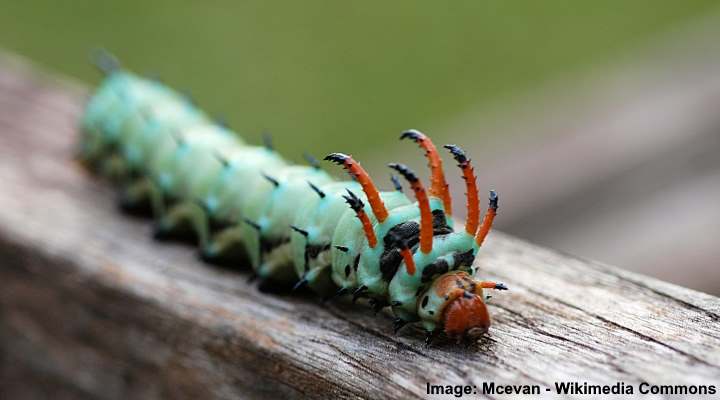
The regal moth caterpillar is a very large caterpillar with orange and black horns on its head
The regal moth caterpillar is a fearsome-looking bluish-green caterpillar with short black spikes, black-tipped orange horns, and an orange tail end. The identifying feature of this huge horned caterpillar is the several arched spiky horns near its head. Also called the hickory horned devil, this insect is the largest caterpillar in the world, measuring a whopping 6” (15 cm) long.
Black and Orange Caterpillar Identification
Regal moth caterpillar identification is by its bright green body, prickly orange and black horns, and small black spikes on its body. Despite its frightening appearance, the caterpillar is harmless and is relatively placid.
- Adult Stage: Regal Moth
- Host Plants: Feeds on a variety of trees including oak, hickory, and walnut.
- Habitat and Distribution: Found in forests and woodlands across North America, particularly in the eastern and southern regions.
- Stinging: The Regal Moth Caterpillar is not known to possess strong stinging capabilities, although its spiny hairs may cause mild skin irritation in some individuals.
Related articles:
